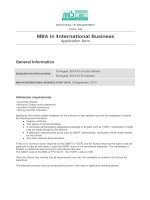International business 7e czinkota moffett ch02
Bạn đang xem bản rút gọn của tài liệu. Xem và tải ngay bản đầy đủ của tài liệu tại đây (915.45 KB, 30 trang )
Chapter 2
Culture
1
Learning Objectives
To define and demonstrate the effect of
culture’s various dimensions on business.
To examine ways in which cultural knowledge
can be acquired and individuals and
organizations prepared for cross-cultural
interaction.
To illustrate ways in which cultural risk poses
a challenge to the effective conduct of
business communications and transactions.
To suggest ways in which businesses act as
change agents in the diverse cultural
environments in which they operate.
2
Expanding Operations Across
Borders
Two distinct tasks
emerge:
to understand
cultural differences
and the ways they
manifest themselves
to determine
similarities across
cultures and exploit
them in strategy
formulation
3
Culture Defined
Culture is an integrated
system of learned
behavior patterns that are
characteristic of the
members of any given
society.
4
Characteristics of Culture
Culture is learned, shared, and
transmitted from one generation to the
next.
Culture can be passed from parents to
children, by social organizations, special
interest groups, the government,
schools, and churches.
Culture is multidimensional, consisting of
a number of common elements that are
interdependent.
5
Acculturation
Acculturation is the
process of adjusting and
adapting to a specific
culture other than one’s
own. It is one of the keys
to success in international
operations.
6
High- versus Low-Context
Cultures
High-context culture
context is at least as
important as what is
actually said
what is not being said
can carry more
meaning than what is
said
focuses on group
development
Japan and Saudi Arabia
are examples
Low-context culture
most of the
information is
contained explicitly in
words
what is said is more
important that what is
not said
focuses on individual
development
The U.S. is an example
7
Change Agents
By introducing new products or ideas and practices, an international business
entity becomes a change agent.
this may shift consumption from one product to another, or
it may lead to massive social change
Many governments take action to protect their culture-specific industries.
8
Cultural Universals
Cultural universals are manifestations of
the total way of life of any group of
people.
These include elements such as bodily
adornment, courtship rituals, etiquette,
concept of family, gestures, joking,
mealtime customs, music, personal
names, status differentiation, and trade
customs.
9
Elements of Culture
Language (verbal
and nonverbal)
Religion
Values and
Attitudes
Manners and
Customs
Material Elements
Social Institutions
Education
Aesthetics
10
The Four Roles of Language
Language aids in information gathering and
evaluation.
Language provides access to local society.
Language capability is increasingly
important in company communications.
Language provides more than the ability to
communicate because it extends beyond
mechanics to the interpretation of contexts
that may influence business operations.
11
Nonverbal language
Distinctions must be made in five key topics:
Time
Space
Material Possessions
Friendship Patterns
Business Agreements
12
Dominant Religions
Christianity
Islam
Hinduism
Buddhism
Confucianism
13
Values and Attitudes
Value of U.S. Culture
The individual can influence
the future
We must work hard to
accomplish our objectives
Commitments should be
honored
One should effectively use
one’s time
Alternate Value
Life follows a preordained
course
Function Affected
Planning and scheduling
Motivation and reward
Hard work is not the presystem
requisite for success; wisdom,
luck, and time are also required
Negotiating or
A commitment may be superbargaining
seded by a conflicting request
Schedules are important but only Long and short range
in relation to other priorities
planning
A primary obligation of the
The individual employee has a Loyalty, commitment,
employee is to the organization primary obligation to the family and motivation
The best qualified person should Family issues and friendship
be given the position available can determine employment
Employment, promotions
recruiting, selection
14
Manners and Customs
Potential ways in which negotiators
may not be prepared:
the understanding of different ways of
thinking
attention to the necessity to save face
knowledge and appreciation of the host
country
recognition of the decision-making process
and the role of personal relations and
personalities
the allocation of time for negotiations
15
Material Elements
Material culture refers to the results of
technology and is directly related to how
a society organizes its economic activity.
It is manifested in the availability and
adequacy of the basic economic, social,
financial, and marketing infrastructure
for the international business in a
market.
16
Material Elements Chart
Material Culture
Economic
Infrastructure
transportation
energy
communications
Social
Infrastructure
housing
health
Financial and
Marketing
Infrastructure
banks
research firms
education
17
Aesthetics
Good taste is
expressed through
colors, form, and
music.
The meanings of
colors and symbols
vary from country
to country.
18
Education
Education, either
formal or informal,
plays a major role in
the passing on and
sharing of culture.
International firms
need to understand
the varying emphases
on particular skills
and the overall level
of education provided.
19
Social Institutions
Social stratification is the division of a
particular population into classes.
Reference groups provide the values and
attitudes that influence behavior.
Primary reference groups include the
family and coworkers.
Social organization determines the roles
of managers and subordinates and how
they relate to each other.
20
Cultural Knowledge
Cultural knowledge can be defined by the
way it is acquired:
objective or factual information is obtained
through communication, research, and education.
experiential knowledge can be acquired only by
being involved in a culture other than one’s own.
Interpretive knowledge is the ability to
understand and fully appreciate the
nuances of different cultural traits and
patterns.
21
Acquiring International Experience
Manager’s ranking of factors involved in
acquiring international expertise
Factor
Assignments overseas
Business travel
Training programs
Non-business travel
Reading
Graduate courses
Precareer activities
Undergraduate courses
Considered Critical Considered Important
85%
83
28
28
22
13
9
1
9%
17
57
54
72
52
50
48
22
Cross-Cultural Behavior Model
Change
Agent
Strategic
Opinion
Leadership
Cognitive
Search
Communication
about
Innovation
Adoption
Tendency
Adoption
Propensity
to Change
Cognitive
Distortion
Cultural
Lifestyle
Evaluation
of
Innovation
Consequences
23
Cross-Cultural Behavior Model
The key variable of the
model is propensity to
change, which is a
function of three
constructs:
cultural lifestyle
change agents
communication about the
innovation
24
Cultural Dimension Scores for 12 countries
100
Japan
U.S.A
France
100
Netherlands
Great Britain
Mexico
Brazil
Uncertainty
Avoidance
Germany
Netherlands
West Africa
50
U.S.A
Great Britain
Germany
Arab Countries
Individualism
France
Japan
Brazil
Arab Countries
Indonesia
50
Mexico
Hong Kong
Hong Kong
West Africa
Indonesia
0
50
Power Distance
100
50
Masculinity
0
25









